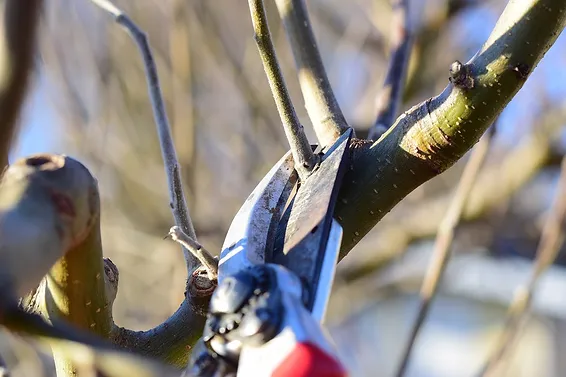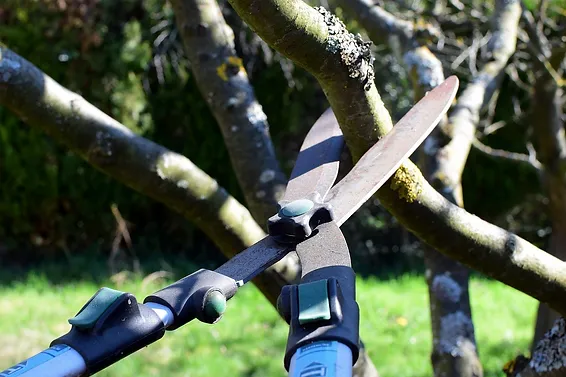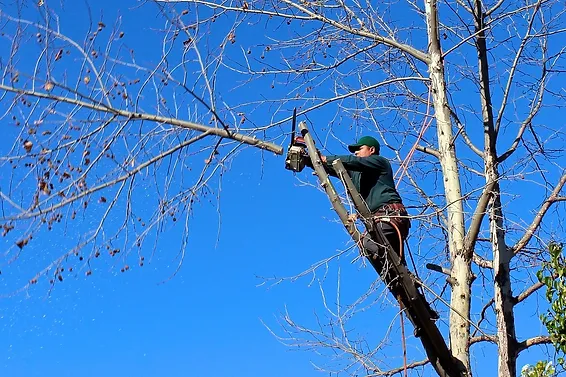Proper tree trimming is essential for the health of your trees, optimal growth, and the safety of your property. Learn how and when you should trim your trees with this definitive guide.

Nearly every species of tree needs occasional pruning or trimming to stay healthy and strong. This might seem odd – what other species require pieces of it to be cut off?
Strange though it seems, trees can become damaged or diseased without this care. In this article, we’ll cover how often you should trim or prune your trees, why trees need to be trimmed in the first place, what time of year you should do it, and whether it is best to trim trees yourself or hire a tree-trimming service.
Why Do Trees Need Pruning? The Science Behind Tree Growth
Trees need trimming for a host of reasons. Over time, new growth can create an overly dense crown or cause the tree to become unbalanced. If the tree is next to a house or utility pole, branches may encroach on these structures, causing a hazard.
Also, crossing (or touching) branches rub against each other in the wind, causing undue stress or wounds to the tree. Throughout the tree’s life, branches will occasionally become diseased or die; this dead wood can become hazardous as it can fall at any time.
This is where pruning comes in. Trimming back some of the tree’s branches periodically can ensure that the tree maintains a solid, balanced structure. It also ensures that there’s sufficient airflow between branches. This helps each branch and its leaves produce optimum energy for the tree. Adequate airflow also prevents fungal and bacterial growth, which can cause disease.
So while you may skip trimming your trees for a year or two with no ill effects, the dense, overgrown branches will eventually create problems for your trees. Trimming keeps your trees healthy and structurally sound.

When Should I Trim My Trees?
It’s preferable to prune trees during their dormant season. This is anytime the tree has cast its leaves and before buds begin to swell. Trimming your trees is easier at this time because you can get a clear view of the entire shape of the tree unimpeded by the leaves.
Trimming your trees in late winter (between February and April in Utah, depending on the year) minimizes the odds that pruning will damage the tender spring bark. It also gives the wounds many months of warm weather to heal so they don’t become hosts to fungi or bacteria. Trimming also sends signals to a tree to break out of dormancy, making late winter/early spring the best time for pruning.
It is possible to prune trees during other times of the year, though you should take additional care as the wounds that trimming creates can become infected or dry out. You can remove dead branches whenever you like, as the dead wood isn’t sensitive to the seasons like live branches are.
How Often Should I Trim My Trees?
It depends on the age and species of the tree. Mature landscape trees only need trimming every three to five years. Juvenile trees need trimming more often, every two or three years. Some freshly planted trees may even need a quick trim to remove dead or broken branches!
Pruning young trees removes structural issues while they’re still small. Trimming crossing branches or those with bad angles is much easier in a young tree. It’s far more expensive and detrimental to the tree to fix them when the limbs are larger. Strive to prune branches before they reach 2 inches in diameter.
For maximum production, fruit trees should be pruned every year. A yearly trim will improve the size and quality of the fruit. Because fruit forms on one-year-old wood, prune between 60% and 80% of new growth each year. This allows new growth to form at a controlled rate so the tree doesn’t become overgrown.
Should I Hire a Professional Tree-Trimming Service or Do It Myself?
Cutting branches off of a tree isn’t particularly difficult for most people. However, knowing exactly where to cut to encourage growth, prevent disease, and protect limbs from falling on fences or other structures — all from a high height — complicates the task considerably. If you’re wondering whether to attempt a tree trimming job yourself, ask yourself these questions:
Does the job require trimming from a ladder?
Are there utility poles, powerlines, or other hazardous structures nearby?
Is the tree unstable or uprooted?
Does the tree pose a risk to fences, sheds, buildings, or other structures?
Are you unsure how to trim your trees (which branches to cut, how close to the trunk to cut, etc.)?
If you answered yes to any of these questions, you’re probably better off hiring a tree-trimming service than doing it yourself. Tree trimming might seem like a straightforward task, but in many cases, hiring a service is the safest move. Many people get injured or die each year trimming their trees, so safety is of the utmost importance.

If you’re looking for a tree-trimming service that has safety as the number one priority, give Rivendell Tree Experts a call. Our trained arborists have the expertise to prune trees in a way that will minimize the stress on the tree and maximize its health and growth. We employ the latest techniques and modern equipment to ensure that you, our crew, and your property are safe during the tree-trimming process.
And if you’re on the fence about whether to hire a service or do the job yourself, we understand. Our quotes are free and come with no obligation. So if it’s a DIY job, we’ll let you know. But if your tree-trimming tasks are too big to handle on your own, let Rivendell Tree Experts help you out. We’ll have your trees looking their best quickly and safely.



